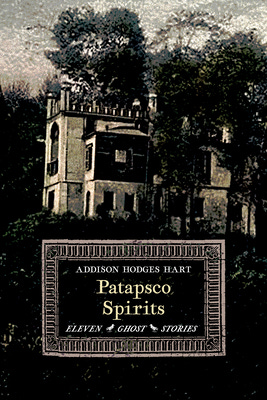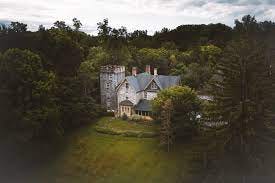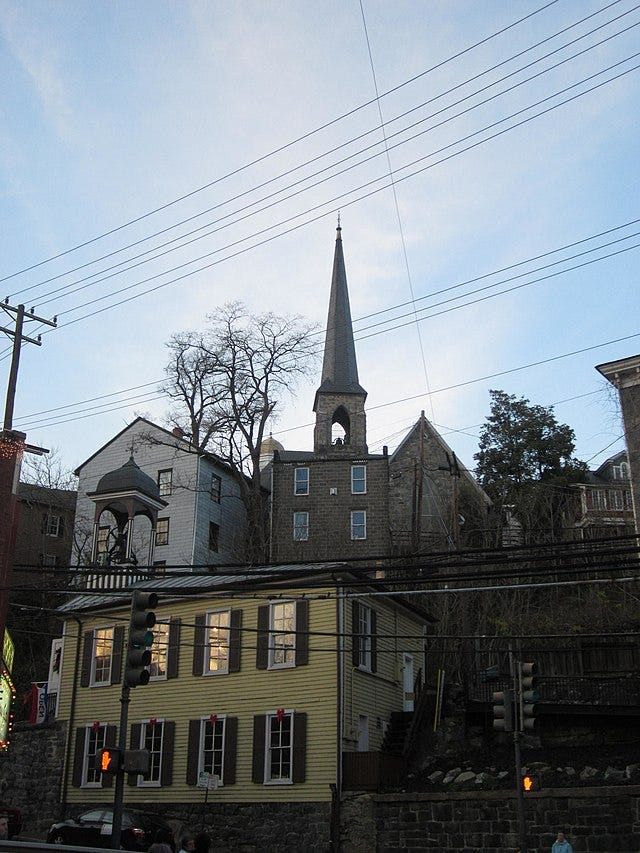My eldest brother Addison—to whose Substack publication The Pragmatic Mystic some of you subscribe—has produced a volume of ghost stories set in the place and era of his (and to a lesser extent my) childhood, and populated by characters both oddly familiar and utterly unknown to me.
Or rather, I should say, it is set in a fictional version of Ellicott City, where we lived when he and my brother Robert were boys and I was but a wee wailing bairn in arms. “Old” or “Historic” Ellicott City is the town center of what is now a sprawling, overly developed suburban district in one of the richest parts of the country, and even today retains a trace of its famous eeriness; but in those days of yore it was a much more unsettling place: an old mill town along a placid stretch of the Patapsco River, at its confluence with Baltimore County’s Tiber River, surrounded by terraced granite scarps and deep woods whose image I cannot summon up in memory now except as bathed in a perpetual autumn twilight (the sky and the river the same pale silver). From 1830, it was the first terminus of the Baltimore & Ohio Railroad on the way out of Baltimore, and during the Civil War it was a transit point and convalescent site for wounded soldiers from both sides. It has also always been a place that legend has associated with preternatural influences of a rather ghastly sort—supposedly not only from its settlement in the 17th century, but from its immemorial Native American past as well. Anyone who remembers the town and its environs as once they were would have no difficulty believing that there are disembodied presences there whose attention it is wise not to court. New England may think of itself as the proper home of the American Gothic, but it is really in those uncanny, always oddly penumbral parts of the mid-Atlantic region where the Northeast meets the upper South that the truly thin places are to be found. Our home in those days was on the hill above the town, in a large house called the Crow’s Nest on account of the somewhat picaresque nautical career of its first owner (one of my distaff ancestors), who retired there to enjoy a prosperous old age but who lost his entire little merchant fleet of a dozen ships or so when they were pressed into service for James Madison’s war and were all sunk by the British Navy (which, I am reliably informed, was fairly formidable in those days). Across the road from that venerable manse was Lilburn, a manor house reputed to be one of the most haunted locations in the country—a reputation, I assure you, that is well deserved—which in those years was in the possession of cousins of ours (again, on my mother’s side of the family).
Anyway, I am rambling. Take my word for it, it was a strange and ghostly place, and while my brother’s stories will not be as specifically evocative for most readers as they are for me, they nevertheless capture enough of the essence of the place (or perhaps enough of its shadows) to create the right kind of unease. There are real local sites, local legends, and local personalities (many of them members of my extended family) reflected in the tales; but there are also a good many local sprites and specters and fetches who are, to my mind, no less real.







Thanks, David, for the plug. I'm rather proud of this collection of stories, and when one's own brother actually praises it... well, one is speechless in amazement. (The ten buck check is in the mail, incidentally.) To those readers of this Substack, if any of you write literary reviews for journals online and/or off, the publisher will send you a review copy. Please let me know if you're interested (addhart@yahoo.com). Thank you.
I remember Ellicott City fondly, not because I ever visited, but because I did a report on Benjamin Banneker in the 5th grade lo these many aeons ago. He had a farm near there and was famous, among other things, for helping to survey for the city of Washington DC in the late 18th century.
https://friendsofbenjaminbanneker.com/history/benjamin-banneker-2/